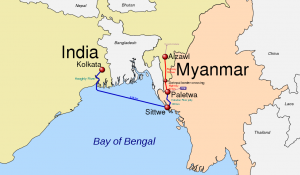The abduction of five Indian Nationals in the Rakhine state of Myanmar by the Arakan Army (an ethnic insurgent group) last Sunday raised tensions across borders. The hostages were released in the early hours of Monday, November 4 after New Delhi’s prompt intervention, while one of the detainees lost his life due to a “cardiac arrest”.[1] It is noticeable that this is the second significant attack on Indian interests with respect to the Kaladan Multi Modal Transit Transport Project (KMMTTP) since January 2019. The Project is among the most ambitious Indian investment in a foreign country. It is finally on its last leg, with most of the other portions complete, or near-complete. The fact that a crucial portion of the Project Infrastructure passes through the areas controlled by the Arakan Army (AA), signals that the threats continue to linger on.
What exactly happened?
On Saturday, November 3, five Indian workers attached to the Project, along with a Burmese Member of Parliament and four local workers, were abducted by the AA cadres. This comes as the second incident threatening India’s interests on Burmese soil, this time involving abduction of Indian Nationals. A similar incident of abduction of local workers working for the Project took place on March 30, this year. A civilian vessel sailing from Yangon to Paletwa that was carrying 300 steel frames for the Paletwa bridge was set ablaze, and the crew members were abducted.[2] These, apart from the other minor incidents raise serious questions on the security of the Indian workers as much as that of the Indian economic and strategic interests.
The Kaladan Project is a highly significant Project that was started after the governments of India and Myanmar entered into a framework agreement in the year 2008. With the obvious motives of overcoming the infamous Chicken’s neck syndrome, as well as seeking a gateway to Southeast Asia, this Project holds immense economic and strategic relevance. As the name suggests, it is a multi-modal transit transport project that involves:-
- A sea-route: Connecting Kolkata’s Haldia Port to the Sittwe Port in Myanmar (539 km)
- A river-route: Connecting Sittwe to the Paletwa town of Myammar’s Chin state via the river Kaladan (Colodyne) (158 km)

Source: Wikipedia
The construction at Sittwe’s sea-port has been completed, and its operationalisation was discussed by Prime Minister Narendra Modi and Myanmar’s State Counsellor Aung San Su Kyi during the 35th ASEAN Summit. The inland water terminal at Paletwa has also been completed. The construction of the 110-km road connecting Paletwa to Zorinpui, after various bureaucratic and security hassles has lately begun, but has often been hampered by the AA threat, which is anything but receding.
A road-route: Connecting Paletwa to a Zorinpui, border town in Mizoram (110 km) and further up to the National Highway 54 (100 km)[3]
The Arakan Army
The Arakan Army is an ethically Buddhist insurgent group that is currently fighting for a confederate status for the Rakhine state. Claiming to have a cadre strength of over 7000, the AA currently operates in the Chin state in western Myanmar.[4] Since the road-route of the Project from Paletwa to Zonrinpui passes through their territory of influence, the Project (which is looked at as a Burmese government venture) is under a constant threat. To safeguard Indian interests, a joint operation was conducted with the Myanmar Army which destroyed 12 AA camps in February-March 2019. Amidst the following minor skirmishes, the attack on the civilian vessel in late March only escalated Indian concerns.
The AA, in response to the attacks involving Indian interests, has been so far clarifying that they do not want to “create problems between the Indian Army and the Arakan Army”[5]. Expressing regret over the death of one of the abducted workers last Sunday, the AA claimed to be “deeply sorry”[6]. It claims that they do not wish to obstruct the road construction under the project, provided that they are “informed” regarding the activities. They have accused the Myanmar Army of using the Project as a cover for “sneaking spies” into their area of operations- what they believe has been turned into a “war zone”.[7]
Contexualising the given series of events, the threats to Indian interests, the AA response regarding them, and the stand of Myanmar, a couple of things get established. The AA response regarding its stand on the Kaladan Project cannot be looked at in isolation.
- One, although providing the insurgents themselves with a transportation route (as they claim), the Indian crackdown on AA actors in the southern Mizoram and beefing up of security on the International border, has acted as a major deterrent for the group to openly attack the Project and come at loggerheads with the IA.
- Two, the successful operationalisation of the Project (with Myanmar government being an active stakeholder) passing through their territory of influence would be a major blow in the AA’s fight for “autonomy”.
Although indirectly, this will keep the threat against the completion of the Project alive with an intent of opposing the government designs. (It must be recalled here that while clarifying of no ill-feelings against the Project after the March 30 incident by the AA, a similar card was played. An information claiming that the “Myanmar Army was transporting ammunition in that vessel” was named as a reason for the attack.)
India’s options
In situations as desperate as these, India needs to play its part to ensure the completion of the already delayed Project- in time, and securely. In order to achieve the said goals, India seems to have two options at hand.
India has already engaged in military cooperation with the Myanmar Army to safeguard its interests. The February operation against the insurgents is the most recent instance establishing that fact. But, it must not be forgotten, that the International Borders were not crossed by either parties during these operations. Intelligence sharing, tightening security across Mizoram border, etc., on the Indian side was actively done.[8] Provided the situations escalate, as they seem, a direct limited engagement of Indian Security Forces to primarily ensure the security of its interests is one option India has. Provided that India refrains from any active engagement on foreign land, the possibilities of this option materialising seem dim as of now. A continued military assistance to the Myanmar Army appears more probable, and possible.
Communication with the insurgents could be another option, but whether India will officially consider establishing communication with Burmese insurgents, is a pertinent question. The northeastern insurgents in India often take shelter by crossing over the Myanmar border. Of late, the Myanmar government has been actively cooperating with India in neutralising these insurgents. In such a scenario, to officially establish any communication with the AA, which is fighting against the Myanmar Army, appears less realistic. At this point, considering the fact despite the continued skirmishes between the AA and the Myanmar Army, negotiations for a ceasefire have never completely stopped, could be a wiser option.
In order to protect the interests of all stakeholders in this respect, encouraging establishing a ceasefire between the insurgents and the Myanmar government might be of crucial importance. Encouraging the assistance of international organisations as and when required, in order to stabilise situations should be considered by all stakeholders. One, it could ensure the secure and timely operationalisation of the KMMTTP. Two, having enhanced the security in the region, it would ensure the smooth functioning of the trade route, once operational. Three, the stable environment could pave a path for greater scope of development of bilateral ties and Indian exploration of resources in Myanmar. Four, all of this combined would be a decisive factor in the progress of India’s Act East policy. Among the available options, it is therefore for New Delhi to decide which one could help achieve maximum gains at a minimum cost.
References:
[1]PIB, “Government of India secures release of Five Indian Nationals abducted in Myanmar”, 5 November, 2019. Accessed on 6 November, 2019. Available at: https://pib.gov.in/PressReleaseIframePage.aspx?PRID=1590382
[2]Hindustan times, “Myanmar Rebel group says army fuelling trouble along Kaladan route”, 7 April, 2019. Accessed on 6 November, 2019. Available at: https://www.hindustantimes.com/india-news/myanmar-rebel-group-says-army-fuelling-trouble-along-kaladan-route/story-zg32WTFqX9lG74NJGG605O.html
[3] Ministry of Development of North Eastern Region, Kaladan Multi-Modal Transit Transport Project. Accessed on 6 November. Available at: https://mdoner.gov.in/infrastructure/kaladan-multi-modal-transit-transport-project-inland
[4] Nikkie Asian Review,“Myanmar’s strategic coastline draws big Asian economies”, 3 July, 2019. Accessed on 6 November, 2019. Available at: https://asia.nikkei.com/Spotlight/Belt-and-Road/Myanmar-s-strategic-coastline-draws-big-Asian-economies
[5]Hindustan times, “Myanmar Rebel group says army fuelling trouble along Kaladan route”, 7 April, 2019. Accessed on 6 November, 2019. Available at: https://www.hindustantimes.com/india-news/myanmar-rebel-group-says-army-fuelling-trouble-along-kaladan-route/story-zg32WTFqX9lG74NJGG605O.html
[6] The Irrawady, “Indian Man Dies, Lawmaker still held after AA abduction in Mynamar’s Rakhine state”, 4 November, 2019. Accessed on 6 November, 2019. Available at: https://www.irrawaddy.com/news/burma/indian-man-dies-lawmaker-still-held-after-aa-abduction-in-myanmars-rakhine-state.html
[7]Hindustan times, “Myanmar Rebel group says army fuelling trouble along Kaladan route”, 7 April, 2019. Accessed on 6 November, 2019. Available at: https://www.hindustantimes.com/india-news/myanmar-rebel-group-says-army-fuelling-trouble-along-kaladan-route/story-zg32WTFqX9lG74NJGG605O.html
[8]Econmic Times, “India tightens vigil along Myanmar border after coordinated operations against insurgent groups”, 15 March, 2019. Accessed on 6 November, 2019. Available at: https://economictimes.indiatimes.com/news/defence/india-tightens-vigil-along-myanmar-border-after-coordinated-operations-against-insurgent-groups/articleshow/68430714.cms













